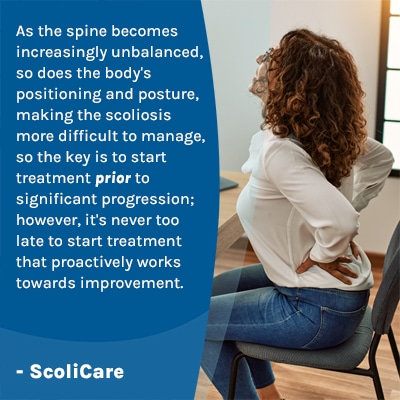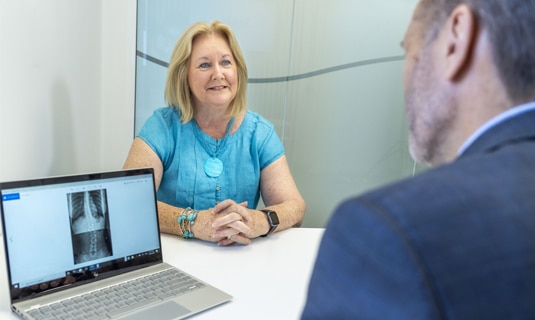Scoliosis progression is triggered by growth spurts, so adolescents are the most at risk for rapid advancement. The key to managing scoliosis effectively is working towards preventing progression, made easier with early detection.
As a progressive condition triggered by growth, scoliosis is ongoing, but it can be highly treatable. With effective treatment, scoliosis progression may be preventable. Treatment plans need to be customized around a number of key factors.
The goal of nonsurgical scoliosis treatment is to restore the spine and body’s balance and stability through realigning the spine and 3-dimensional postural correction.
Understanding Scoliosis
Scoliosis causes the development of an unnatural sideways spinal curve that also rotates, and most cases are progressive (1, 2).
Scoliosis progression means the size and rotation of the unnatural spinal curve is increasing, making the scoliosis more severe and the spine increasingly unbalanced.
The more progression that occurs, the more difficult it can be to reverse its effects, and with increasing spinal rigidity, the spine becomes less responsive to treatment.
Understanding the progressive nature of scoliosis, and the role of growth, is key to the importance of early diagnosis (3).
With awareness, the early signs of scoliosis can be more recognizable, and scoliosis can be managed more proactively and effectively (2).
The key to early detection is recognizing the early signs of scoliosis so it can be diagnosed while mild and treatment started early.
Recognizing the Early Signs of Scoliosis for Early Detection
 There are no treatment guarantees, but diagnosing scoliosis while mild means there is an opportunity: the opportunity to start treatment while curves are at their smallest and most flexible.
There are no treatment guarantees, but diagnosing scoliosis while mild means there is an opportunity: the opportunity to start treatment while curves are at their smallest and most flexible.
Early detection and intervention are particularly beneficial when it comes to childhood scoliosis (3).
As progression is triggered by growth, children can experience rapid advancement of the curve during periods of rapid growth, but if treated proactively, because a child’s spine is still growing, it’s more flexible and can be highly responsive to a variety of nonsurgical treatment options (1, 3).
So the key is to diagnose scoliosis early by recognizing the earliest signs of scoliosis; patients of all ages can benefit from early detection and intervention.
Early Signs of Childhood Scoliosis
Childhood scoliosis affects infants, juveniles, and adolescents.
The most common form of scoliosis overall is adolescent idiopathic scoliosis diagnosed between 10 and 18 years of age. It’s typically diagnosed around 12 years of age, is more prevalent in females, and is prone to rapid advancement due to pubescent growth spurts (1, 3).
As scoliosis causes the spine to become misaligned, it can cause postural changes, and in many cases of childhood scoliosis, the earliest telltale signs of scoliosis onset are uneven shoulders and uneven hips.
If mild scoliosis progresses to moderate or severe, increasing postural changes to look for include uneven shoulder blades, one side of the rib cage protruding more than the other, a prominent lean to one side, and increasing asymmetry in the shoulders and hips (3, 4).
The main challenges to early detection of childhood scoliosis are the subtlety of mild scoliosis symptoms.
Early postural changes can be subtle and difficult to notice, especially if an adolescent isn’t being forthright about bodily changes they don’t understand; this makes it even more important for parents and/or caregivers to be aware of what to look for.
Disruptions to healthy movement patterns are also common as a patient’s gait, balance, and coordination are disrupted (3).
As the spine becomes increasingly unbalanced, so does the body’s positioning and posture, making the scoliosis more difficult to manage, so the key is to start treatment prior to significant progression; however, it’s never too late to start treatment that proactively works towards improvement (3, 4).
The key to early detection is recognizing the early signs of scoliosis and the benefit of screening, and this means awareness of scoliosis risk factors (3, 4).
Scoliosis Risk Factors
Scoliosis risk factors include age, gender, and family history (1, 3, 4, 5).
As discussed, scoliosis is most often diagnosed around the onset of puberty, so it can be beneficial to start screening for scoliosis prior to the first significant pubescent growth spurt capable of causing significant progression (2).
Gender is also a risk factor as female adolescents are diagnosed earlier and are more at risk for progression, and this is related to the earlier onset of puberty in females.
While scoliosis isn’t considered a genetic condition, it can be described as familial; having another family member diagnosed with scoliosis increases the likelihood of another family member being diagnosed (4).
So for parents of children approaching puberty with a family history, scoliosis screening should take place during routine check ups as this may lead to early detection and treatment success (1, 3).
While children can benefit from early detection because they are more prone to rapid advancement, adults can also benefit because they are prone to age-related spinal degeneration (5, 6).
Early Signs of Adult Scoliosis
Adults are affected by two main types of scoliosis: adolescent scoliosis in adults (ASA) and degenerative de-novo scoliosis (DDS) (5, 6).
Adolescent scoliosis in adults can be pre-existing from adolescence, or scoliosis can develop in later adulthood with no prior history as degenerative scoliosis (1, 6).
When assessing an adult’s scoliosis, the first step is determining if it’s pre-existing or degenerative.
Many cases of adolescent scoliosis in adults involve adolescents not being diagnosed and treated because they were unaware of the scoliosis; once growth stops, the effects of scoliosis can become more noticeable, including pain.
Postural/Movement Changes and Pain
Adults also experience postural and movement changes, but it’s most often pain that leads to assessment and diagnosis, and when it comes to degenerative scoliosis caused by degenerative instability, these cases are almost always progressive and painful (5, 6).
Lower back pain is the most common symptom of adult scoliosis, and as the spine becomes increasingly unbalanced and unstable, this also increases the risk of injury through a fall, and leg pain is also a common complaint (5, 6).
Recognizing the early signs of adult scoliosis can mean starting treatment while there is more natural spinal function to preserve and there is more potential to slow and/or prevent further degenerative changes.
So the best way to manage scoliosis is through proactive conservative treatment plans that are individualized and combine multiple treatment disciplines.

Proactive Scoliosis Treatment
Scoliosis patients of all ages can benefit from a customized and proactive treatment plan that has the potential to realign the spine and improve posture for 3-dimensional correction.
The ScoliCare approach is about restoring the spine and body’s balance through improving the spine’s position, body posture, and the balance and strength of the spine’s surrounding muscles (7).
A nonsurgical scoliosis treatment plan will include scoliosis specific exercises to improve the health of the spine’s surrounding muscles; this means more support and stability for the spine (1, 6, 7).
Scoliosis-Specific Exercise and Corrective Bracing
ScoliBalance® is an individualized scoliosis-specific exercise program that combines the best of what chiropractic care, physical therapy, and exercise has to offer, and when combined with the potential of a corrective brace like the modern ScoliBrace®, the scope of nonsurgical treatment is wider than ever before (7, 8, 9).
ScoliBalance® treatment plans are custom-designed by a team of experienced Clinicians and combine scoliosis-specific chiropractic care, involving manual adjustments to reposition the spine and increase the spine’s flexibility, with other facets of treatment (7).
Changes to the position of the spine’s vertebrae need to be supported, however, which is where ScoliBalance® can help by improving the spine’s surrounding muscle strength and balance (7).
ScoliBalance® uses a combination of Mirror Image®, and multiple methods of physiotherapeutic scoliosis specific exercises (3), in addition to corrective breathing (3, 4), exercise to teach patients how to position their spines and bodies to best counteract their specific curve, hold the spine in an aligned position, improve posture, and sustain treatment results (7).
Scoliosis-specific exercises with corrective potential are taught in-clinic, and when patients are comfortable and capable, the exercises can be performed from home to further stabilize the spine and apply the postural awareness and restoration to daily activities.
The complexity of scoliosis necessitates the application of multiple treatment disciplines, and when ScoliBalance® is combined with a corrective brace like the ScoliBrace®, there is more potential to improve and manage scoliosis effectively (7).
The corrective ScoliBrace® is used to address scoliosis in children, adolescents, and adults. It’s custom-designed with comfort and mobility in mind, so it can be combined with the power of ScoliBalance® ; the treatment disciplines work together to improve the spine’s alignment for 3-dimensional postural improvement (7).
Conclusion
The sooner treatment is started, the better. Early detection of childhood scoliosis has the potential benefit of starting treatment prior to the start of rapid growth spurts and/or counteracting the progressive nature of scoliosis during growth.
When it comes to diagnosing adult scoliosis early, this can mean starting treatment while the spine still has a decent range of motion and function to preserve, and/or preventing further degeneration and progression.
Early detection of adult scoliosis can also help with fall prevention in older adults diagnosed with degenerative scoliosis.
Although we don’t fully understand why most cases of scoliosis initially develop, we know it’s growth that triggers progression. A progressive condition like scoliosis is ongoing and can benefit from a proactive treatment plan that combines the potential of scoliosis-specific chiropractic care, scoliosis-specific exercise, and corrective bracing.
Here at ScoliCare, our focus is nonsurgical scoliosis treatment for patients of all ages, but we are also leaders in education, research, and spreading awareness.
With progressive conditions like scoliosis, when treatment is started can be a key factor in how a patient’s spine responds to treatment, so when it comes to managing scoliosis effectively, knowing the early signs of scoliosis to look for can increase potential treatment efficacy.
References:
- Palazzo C, Montigny JP, Barbot F, Bussel B, Vaugier I, Fort D, Courtois I, Marty-Poumarat C. Effects of Bracing in Adult With Scoliosis: A Retrospective Study. Arch Phys Med Rehabil. 2017 Jan;98(1):187-190. doi: 10.1016/j.apmr.2016.05.019. Epub 2016 Jun 22. PMID: 27343345
- Weinstein SL. The Natural History of Adolescent Idiopathic Scoliosis. J Pediatr Orthop. 2019 Jul;39(Issue 6, Supplement 1 Suppl 1):S44-S46. doi: 10.1097/BPO.0000000000001350. PMID: 31169647.Schwab F, Dubey A, Gamez L, Benchikh El Fegoun A, Hwang K, Pagala M and Farcy
- Negrini S, Grivas TB, Kotwicki T, Maruyama T, Rigo M, Weiss HR; Members of the Scientific society On Scoliosis Orthopaedic and Rehabilitation Treatment (SOSORT).
- Why do we treat adolescent idiopathic scoliosis? What we want to obtain and to avoid for our patients. SOSORT 2005 Consensus paper. Scoliosis. 2006 Apr 10;1:4. doi: 10.1186/1748-7161-1-4. PMID: 16759352; PMCID: PMC1475888.
- Zaina, F., Marchese, R., Donzelli, S., Cordani, C., Pulici, C., McAviney, J., & Negrini, S. (2023). Current knowledge on the different characteristics of back pain in adults with and without scoliosis: a systematic review. Journal of Clinical Medicine, 12(16), 5182.
- McAviney, J., Roberts, C., Sullivan, B., Alevras, A. J., Graham, P. L., & Brown, B. T. (2020). The prevalence of adult de novo scoliosis: A systematic review and meta-analysis. European Spine Journal, 29(12), 2960-2969.
- Marchese, R., Du Plessis, J., Pooke, T., & McAviney, J. (2024). The improvement of trunk muscle endurance in adolescents with idiopathic scoliosis treated with ScoliBrace® and the ScoliBalance® exercise approach. Journal of Clinical Medicine, 13(3), 653.
- Wise CA, Gao X, Shoemaker S, Gordon D, Herring JA. Understanding genetic factors in idiopathic scoliosis, a complex disease of childhood. Curr Genomics. 2008 Mar;9(1):51-9. doi: 10.2174/138920208783884874. PMID: 19424484; PMCID: PMC2674301
- Marty-Poumarat, Catherine MD*; Scattin, Luciana MD†; Marpeau, Michèle MD*; Garreau de Loubresse, Christian MD‡; Aegerter, Philippe MD, PhD§. Natural History of Progressive Adult Scoliosis. Spine 32(11):p 1227-1234, May 15, 2007. | DOI: 10.1097/01.brs.0000263328.89135.a6


